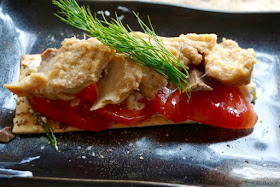The center layer is "wasabi" flavored cottage cheese.
Ingredients:
Red layer
3/4 cup buttermilk
1 lime squeezed
2 3/4 cup watermelon puree
2 envelopes unflavored gelatin
White layer
1 envelop gelatin
1/4 cup milk or cream
1 3/4 cup cottage cheese mashed
1/4 cup mayonnaise
1/4 tsp salt
2 limes squeezed
1 tbs wasabi (or to taste)
Puree the watermelon. Take 1/2 cup of the puree and use it to bloom the gelatin. Heat the bloomed gelatin in the microwave for 30 seconds. Add the gelatin to the rest of the puree. Pour half the puree into the bottom of the casserole dish and let it jell in the refrigerator until solid. (Keep the remaining puree at room temperature and it will stay liquid.)
Mash the cottage cheese. Add the mayo, salt, lime juice. Take some of the cottage cheese mixture, add it to a small bowl and use it to soften the wasabi. The amount of wasabi is basically to taste. I found that the cottage cheese tends to calm it down so I end up putting in a fairly large amount. Once it has been homogenized into the amount in the small bowl add it to the large bowl and stir until it is incorporated. Bloom the gelatin in the milk. Heat in the microwave for 30 seconds until melted. Add to the bowl of cottage cheese. Pour the cottage cheese over the watermelon layer and cool until solid.
Add the remaining watermelon puree on top of the cottage cheese layer and cool until solidified.
This is a refreshing summer side dish. The watermelon flavor comes through and goes very well with the cottage cheese layer. The wasabi really makes this dish. Because of the cottage cheese and mayo the wasabi is not "clean out your sinuses" intense. Instead it adds a nice little bite that goes well with watermelon and adds to the refreshing flavor. Also mayo and wasabi are another surprisingly good flavor combination. This is a good variation for my wife's historic ribbon salad.
BTW the pureed watermelon served with wasabi cream makes a very nice cold melon soup.





































